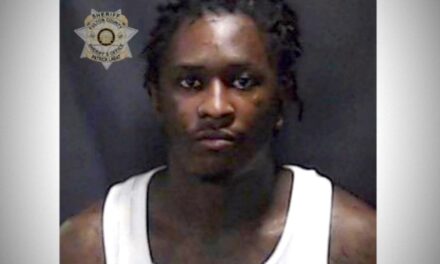African American Activists And Others Call For Dismantling What Remains A ‘Peculiar Institution’
By Genoa Barrow | OBSERVER Senior Staff Writer
Enslaved Blacks who were prone to running away from their white oppressors often were placed in iron shackles and had large, multipronged collars locked around their heads to make escape a difficult and noisy endeavor.
Armed with the intrinsic knowledge that they were meant to be free and aided by abolitionists Black and white, thousands still found a way to extricate themselves from bondage, from the “peculiar institution” that was American slavery. Today, millions of African Americans remain fettered, locked up behind steel bars and iron doors in state and federal prisons.
Some argue there is a significant difference between them and their enslaved ancestors because they had “the freedom” to choose the path that led them to being locked up. Others who fight for prisoners’ rights on the outside refer to their movement to vastly change the prison system as we know it as modern abolition.
“We have to start with disruption,” says social justice organizer Toni McNeil. “We have to start with understanding the history of policing. The history of policing is rooted in slave catchers, and you were property.”
Understanding how and why things are now, requires us to look back, says McNeil, who regularly discusses mass incarceration’s impact on the Black community in her podcast, “Anti-Black Conversations.”
“This system was rooted in racism,” McNeil says. “It was rooted in bias. It doesn’t benefit race; it doesn’t benefit gender. It’s not inclusive. There is no belonging in this system. It’s not designed for that. This system benefits older white men.”
While Blacks certainly aren’t the only ones doing time, they are disproportionately represented in American jails and prisons. African Americans are incarcerated at a rate five times higher than whites. Blacks make up 13% of the nation’s population, yet according to the Prison Policy Initiative, represent 38% of the country’s prison population.
About 80% of California’s prison population is made up of people of color, experts say. In Sacramento County, African Americans make up nearly 39% of the jail population.
Decarcerate Sacramento, a local activism group, has implored county leaders to center race in the solution to mass incarceration.
“Sacramento County cages Black people at four times the rate of white people and Black people are by far the most overrepresented group in our local jail system,” Liz Blum, the organization’s co-founder, said at a July 11 county Board of Supervisors’ meeting.
“Centering racial equity means asking why, getting to the root causes of this inequity and implementing intentional solutions that shift racist systems of policing and incarceration. The lack of coordinated racial equity strategy means that this county will continue its racist practices of overpolicing Black people without looking at systemic root causes like continued county underfunding of Black neighborhoods,” Blum continued.
Society’s Troubling Choice
“I think that our system is actually functioning for those that created it. It’s just not functional for us.”
– Toni McNeil.
Many factors play into incarceration numbers: lack of job opportunities in communities of color; an educational system that does in fact leave many Black children behind; a culture where criminal behavior is glorified in mass media and going to prison is seen as a generational curse or rite of passage.
A national “war on drugs” that targeted African Americans also has played a role. California’s prison population swelled thanks to its notorious “three strikes” law. Passed in 1994, the law imposes a life sentence on those with two prior convictions for serious or violent felonies. Doubling sentences for repeat felons was supposed to be a deterrent to criminal behavior, thus reducing the crime rate.
Many point to the negative effect increased incarceration, as well as insufficient or nonexistent rehabilitation programs, has had on an already overburdened system.
Decarcerate Sacramento has been vocal in demanding that officials reduce the county’s jail population, pointing out dismal conditions and lack of services for the mentally ill, and decrying several recent in-custody deaths.
“Sacramento County jails are deadly, dehumanizing and perpetuate violence every single day,” says volunteer organizer Jael Barnes. “They are not preventing harm and violence in our community, only exacerbating it. Our community deserves real solutions for keeping our communities safe and healthy.”
As California closes some facilities and “reimagines” others, prisoners’ rights advocates urge an even deeper dive into the root causes of mass incarceration and the “machine” that feeds it.
Mass incarceration’s impact on Black people is multileveled and isn’t always as cut-and-dry as “if you do the crime, you do the time,” says local ACLU attorney Carmen-Nicole Cox.
“I would definitely agree that it’s complicated,” Cox says. “Even now we see legislation that attempts to ratchet up punishment for crimes. The way crimes are enforced and investigated, is in and of itself, disproportionately targeted at Black folks and other people of color, because that’s where the law enforcement officers spend their time.”
The narrative of Blacks as innately dangerous and criminal-minded was created to justify slavery, and later the prison industrial complex, to support the economies sustained by them. Advocates and legal proponents say mass incarceration in America can’t be effectively addressed without unpacking racial inequality in America, racism in the criminal justice system and the disparate socioeconomic conditions that exist in many Black communities and act as barriers to success.
“Folks want to believe that there are more Black people sitting in prison, a disproportionate number of Black people sitting in prisons and jails, because Black people commit more crime, or Black people are innately more inclined to engage in criminal conduct,” Cox says. “First off, the real issue is that poverty begets crime. We know that systems have intentionally maintained and injected levels of poverty into the Black community, whether it was denying us the right to build wealth … whether it’s denying jobs or denying promotions at the job. We’ve been litigating our humanity forever and part of our humanity has been, ‘Hey, can we live? Can we grow? Can we get educated? Can we save? Can we pass down generational wealth?’ The answer time and time again has been no. The result of that has been people engaging in conduct where they’re like, ‘I am going to get what I need.’”
Poverty, previous exposure to violence, mental illness, or melanin for that matter, don’t give a person a pass or permission to wrong others unchecked.
“It’s not a justification,” Cox says. “It’s not an excuse. What I’m saying, though, is that this doesn’t happen in communities where people are happy, where rent is paid, where lights are on, where there’s food in the refrigerator.
“We know how to alleviate and unwind mass incarceration, but we choose not to, even though we know that the systems that are in place are the cause of mass incarceration. People who have full bellies, are in stable housing, whose children are safe, who have public transportation and opportunities to get to good-paying jobs, to get to grocery stores, that have healthy food – those aren’t the folks who are committing crimes. That’s no matter if you’re Black or white. But then go into the Black community and see all of the deficits that we’re forced to deal with. That is how we get to mass incarceration, not because Black folks were born criminally inclined. That’s not true.”
Few Resources, Few Options

“Lock ’em up and throw away the key” mindsets annoy Barnes. She joined Decarcerate Sacramento to help advocate for her incarcerated husband.
“They have no clue what a lot of folks go through,” she says of people who are quick to dismiss those behind bars.
“You don’t know what somebody is dealing with,” Barnes says. “You don’t know that [this person] is over here, he has tried to get a job, but doesn’t have the proper tools to get those jobs; he doesn’t have the education or maybe he’s been working to get a job, but they don’t want to pay him anything. His baby needs diapers and he’s not going to let his baby go without, so he goes to the store, and he has nobody helping him.
“You have to literally lie to get food stamps, welfare and everything else. I see it in the eyes of the people that I truly have been around. A lot of times they don’t want to do the things that they do, but a lot of the times they were born into this. I know some folks who have dealt drugs, but it’s because that’s what they saw. That’s the only thing that they knew. Nobody else taught them any better than that. And I honestly don’t understand why people even make those comments about, ‘Well, if you do the crime, you have to do the time’ and other bullcrap. Walk in their shoes. Please, walk in their shoes.”
Barnes and other organizers urge people who get out of prison to speak out, adding their experiences to the conversation and efforts to shake up the system. One of Decarcerate Sacramento’s initiatives, Inside/Outside, was started by women in county jail.
“They’re still a part of the program,” Barnes says. “Anytime someone gets out, we try to center them and try to get them involved so that they can tell their stories.”
Barnes was empowered by the group to speak out on her husband’s behalf and now acts as a pretrial organizer, working with people like him who are in jail but have yet to be convicted of anything. Thousands of people locally are in that situation. Some have charges that aren’t eligible for bail; others can’t afford bond or adequate legal representation. Some have been advised by their attorneys to stay put because with almost certain convictions in their future, they may be released on account of time served.
“It isn’t that you are innocent until proven guilty. In fact, it’s the total opposite,” Barnes says. “You are guilty until proven innocent and they’re going to make sure that they don’t prove you innocent because you’re going to sit so long that you are willing to take a deal. [You think], ‘I want to be back home with my family. I want to be back in society, so even though I may not even have done the crime, I’m tired of sitting here, so yes, I’ll take that deal.’”
System Designed To Subjugate
Lance Wilson, a formerly incarcerated Bay Area man now working to help social justice organizations statewide, balks at assertions that “the system is broken.”
“It’s a machine and it’s working exactly the way they designed it to work,” says Wilson, a communications specialist with the Worker Agency.
“There’s always so much scrutiny on police,” Wilson says. “I want the scrutiny to be on the prosecutors and the judges because they’re some of the crookedest people in this world. It’s like they get immunity. There’s no backlash for them. They can send people away for 20, 30, 40 years, and they didn’t even commit a crime. It’s mind-boggling to me just to see how the whole system works.
“They come up with all these wars on drugs, but you go to their neighborhoods, it’s not like that. Their neighborhoods have the most resources and we have the least resources. We have the most cops in our neighborhood and the resources we’re looking for aren’t the type of resources they put in our communities.”
Social justice organizer Toni McNeil has similar thoughts. The Stockton native has more than 25 years’ experience in leadership development and advocacy for the formerly incarcerated, the homeless community and residents in neighborhoods highly impacted by overpolicing, gun violence and mass incarceration.
“I don’t know whether or not I would agree that the system is broken because something that is broken isn’t functioning,” McNeil says. “This system was created by white men, patriarchal, that had slaves, and it was created in order for it to do ‘a thing.’ Our constitution hasn’t been changed, ever. It’s still the same. It’s still built on what our forefathers created it to be. I don’t think there was a Black man who was there helping to create that constitution.
“I don’t think that our system is broken. I think that our system is actually functioning for those that created it. It’s just not functional for us.”
In 2022, President Joe Biden declared April to be Second Chance Month, stressing the importance of helping formerly incarcerated individuals reenter society.
“America is a nation of second chances,” President Biden wrote in his proclamation. “Supporting people who are committed to rectifying their mistakes, redefining themselves, and making meaningful contributions to society, we help reduce recidivism and build safer communities.”
Approximately 640,000 people are released from state and federal prisons every year. More than 70 million Americans have spent time in jail or prison and have criminal records. Records and legal restrictions create significant barriers that prevent formerly incarcerated individuals from accessing basic opportunities such as employment, housing, voting, education and business licensing. Because of these barriers, nearly 75% of formerly incarcerated people remain unemployed a year after being released.
“We must rethink the existing criminal justice system and who we send to prison and for how long; how unaddressed trauma and abuse create pipelines to incarceration; how people are treated while incarcerated; how prepared they are to reenter society once they have served their time; and how the racial inequities that lead to disproportionate numbers of incarcerated people of color and other underserved groups,” Biden wrote.
Dismantling a centuries-old way of doing things may be an uphill battle, but area activists say it’s worth the climb. While not officially a part of the abolition movement, McNeil says the more she learns about it, the more she sees the bigger picture.
“The more in depth that I get into realizing that our humanity is what’s been at stake, the more I realize that in order for our community to heal, we need to take responsibility for the healing of ourselves, one person at a time,” she says. “I don’t think that it’s a system that can be repaired. It’s a system that needs to be dismantled, abolished, and then redefined, reestablished and created anew.”
Over the coming weeks, “Inside Out” will highlight the experiences of formerly incarcerated individuals and their families, look at efforts to improve local jail and prison facilities, and share the perspectives of Black correctional staffers and attorneys who work on change from within and activists who have dedicated their lives to shining a light on the inequities of the criminal justice system.





